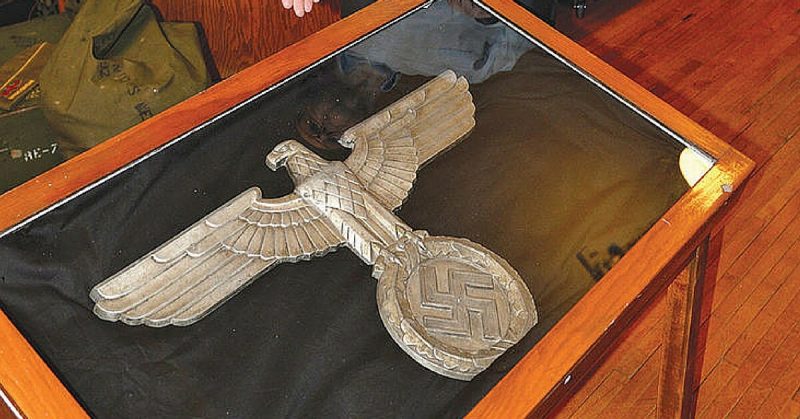Detective Kirk Hill, of Duluth, Minnesota, was certainly not looking for a challenging and complicated case, but this particular report was too enticing to pass up. He was presented with an opportunity to potentially discover a longtime missing metal eagle that might have been a decoration piece in Adolf Hitler’s private train. At the time, Hill was already inundated with other cases.
That was until a patrol officer passed along information about the eagle’s whereabouts to the Superior Police Department’s investigations division. Hill became deeply interested in pursuing a case that involved an actual piece of World War II history.
Hill is described as a history buff who is particularly interested in the American Old West and World War II history. He knew this would be an interesting case and jumped at the chance to investigate. Once Hill was awarded the case he took on the help of Detective Jack Curphy, whom he felt had good ideas on how to approach this kind of less conventional investigation.
Tony Tracy, the Douglas County Historical Society Executive Director who reported the potential theft on August 25, had made it routine to sift through the Craigslist antiques section every month or so. He found the metal eagle emblem posted for sale in nearby Eveleth.
The piece was listed for $3,200, which initiated a spell of déjà vu. It reminded him of an identical piece that was donated to the Historical Society in 1946. It had been brought back from Europe after World War II ended. At that time, it was featured in an Evening Telegram article and assigned an accession number. Soon after, it went missing from the society’s collection.
Tracy contacted Superior, Wisconsin, police, and three days later Hill presented the eagle to Tracy. Hill described the hand-over in detail: “His eyes were super-wide. He was at a loss for words.”
The eagle was taken to experts who examined it closely. They were more than 90 percent sure that it was the same eagle that had been presented to the Historical Society almost seven decades earlier, the same one that was allegedly taken from Hitler’s personal train. It is still unclear how and when the eagle disappeared from the Historical Society.
Detection in Reverse
To start the investigation, Hill called the number posted in the online ad claiming to be a World War II memorabilia collector. Just two days after Hill asked for the case, he traveled to Eveleth with Curphy. Upon their arriving at the seller’s house of residence, his girlfriend answered the door. The two detectives inquired about the eagle that had been sold but ended up getting more than they had expected.
The girlfriend looked at them and pointed over to the wall. The chrome metal emblem looked real and was just leaning up against the wall. According to Hill, “It was aged, it was antique, and it had a patina finish on it. You could tell it was authentic.”
The man who posted the online ad cooperated and gave detectives permission to test the emblem. The experts were able to determine that the eagle was authentic. Hill then decided to refocus the investigation to try to determine when the eagle was taken from the Historical Society.
The detective started by reaching out to the Craigslist seller for the second time. The seller claimed that he had taken the eagle from a shed at a local scrap metal business. The business was purchased 20 years ago by the current owner, who did not know about the artifact. He explained that it was certainly possibly that the artifact could have been in the building since the time he purchased the place.
Hill contacted the former owner’s son-in-law, who still resides in Eveleth, in hopes of finding a link. It started with a phone conversation before meeting in person. The man from Eveleth said that his son recalled seeing the eagle when he worked at the scrap metal business in the 1970s as a teenager. Hill reached out to the son, who described seeing the eagle in 1976 while cleaning out a shed.
It is still unknown who actually took the eagle from the Historical Society. Since the Eveleth business owner frequently traveled to Superior and Duluth to buy and sell scrap metal, it is impossible to determine who might have sold the artifact to the business.
Hill said, “That confirms that for at least the last four decades the stolen artifact from the Douglas County Historical Society was housed at the scrap metal storage facility, but the investigation ends there. It just pulls it all together and confirms the fact that it was the one taken from the museum at least 40 years ago.”
For now, the eagle is being stored in a locked case at the Historical Society. It remained on display until April 30, when it was given to the Richard I. Bong Veterans Historical Center.
This eagle has tremendous historical significance as a World War II artifact. Hill emphasized, “That was the cornerstone of the building blocks of the Nazi war machine and the American soldiers and Allied soldiers went over and disassembled that and brought back a piece of it. To be able to hold that in your hands, that piece of history, was pretty fascinating.”
Tracy agreed with Hill’s sentiments that it was an amazing piece, but felt it was counter to the county historical society’s aims. He explained, “We’re more about preserving our culture here, the mementos and stories of all the people who lived here.”
Hill is happy with the idea that the eagle will be sent to the Bong Memorial. It seems like a more appropriate place. Of course there are some unknowns related to the case, but at least some of it was resolved. Tracy called it a “real mystery at the museum.”
